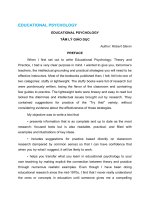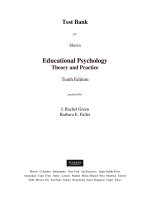Educational psychology final essay topics
Bạn đang xem bản rút gọn của tài liệu. Xem và tải ngay bản đầy đủ của tài liệu tại đây (233.9 KB, 4 trang )
<span class="text_page_counter">Trang 1</span><div class="page_container" data-page="1">
<b>EDUCATIONAL PSYCHOLOGY – FINAL PROJECTS</b>
Essay length: 1500-5000 words
Requirement: Develop a full essay using the template and based on what you have learned from the coursebook, in class and from other reliable, relevant sources. Cite the sources in the Reference part.
Due date: 8 April 2024 Coursebook:
<i>Citation: Santrock, J. W. (2021). Educational psychology. McGraw-Hill Education. </i>
In-text citation: (Santrock, 2021)
<b>Choose ONE of the following case studies to write about. Answer all the questions that follow based on what you have learned in class and from the coursebook.</b>
<b>Case study 1: CONSEQUENCES (p.249)</b>
Adam, a student in Mr. Potter’s fourth-grade class, is disruptive from time to time although he is very bright. One day during language arts, Adam began talking loudly to other students in his area. He was also laughing and telling jokes. Mr. Potter chose to ignore Adam’s behavior, hoping he would stop on his own. But Adam didn’t stop. Instead, his behavior became more raucous. Still Mr. Potter ignored it. Soon Adam was making enough noise that Mr. Potter was afraid that students in the neighboring classrooms would be disturbed, so he verbally rep- rimanded Adam.
Adam was a bit quieter for the next few minutes. After that, however, he once again became loud and disruptive. Again Mr. Potter verbally reprimanded him. This time he also told Adam that if he continued with his disruptive behavior, he would have to go to the office. Adam’s behavior became even more disruptive, so Mr. Potter sent him to the office. When Adam arrived at the office it was full of people— teachers getting their mail and making copies, volunteers signing in, students who were ill, students sent on errands, and other students who had been sent for disciplinary reasons. The school secretary told Adam to have a seat, which he did. He conversed with every person who entered the office as well as those who were
</div><span class="text_page_counter">Trang 2</span><div class="page_container" data-page="2">there when he arrived. Half an hour after his arrival, he was sent back to class. He behaved quite well for the rest of the day, to Mr. Potter’s relief.
The next day when students were assigned to write a paragraph, Adam once again became disruptive. He loudly told jokes to his classmates, laughed until tears were streaming down his face, and threw a paper airplane across the room. Mr. Potter reprimanded him and asked him to stop. When Adam didn’t comply, Mr. Potter sent him to the office, which was once again bustling with activity.
Over the course of the next two weeks, Adam was sent to the office for disrupting class each day, always during a writing assignment. Mr. Potter was perplexed. Even more perplexing was that within three school days other children were becoming disruptive as well, requiring that they too be sent to the office.
<i><b>1. What are the issues in this case?</b></i>
<b>Answer the following questions using principles of behavioral learning theories and correct terminology: </b>
<i><b>2. Why did Adam continue to disrupt class despite the consequences? </b></i>
<i><b>3. What has Adam learned? </b></i>
<i><b>4. Why did the other students join Adam in his disruptive behavior? 5. What should Mr. Potter do now? </b></i>
<i><b>6. What was Mr. Potter most likely trying to do when he initially ignored Adam’s disruptive behavior? </b></i>
a) He was trying to extinguish the behavior by not reinforcing it. b) He was trying to negatively reinforce the behavior.
c) He was trying to positively reinforce the behavior. d) He was trying to punish the behavior.
<i><b>7. If Adam’s goal was to escape writing assignments, which of the following best explains the consequences in operant con- ditioning terms? </b></i>
a) Adam was negatively reinforced for his behavior. An aversive stimulus was removed.
b) Adam was positively reinforced for his behavior. A pleasant stimulus was presented.
</div><span class="text_page_counter">Trang 3</span><div class="page_container" data-page="3">c) Adam was punished for his behavior. A pleasant stimulus was removed. d) Adam was punished for his behavior. An aversive stimulus was presented.
<b>Case study 2: THE TEST (p.290)</b>
George has a test next week in his eighth-grade history class. He is having considerable difficulty remembering terms, names, and facts. On his last test, he identified General Sherman* as a Vietnam War hero and Saigon as the capital of Japan. Historical dates are so confusing to him that he does not even try to remember them. In addition, George has difficulty spelling.
The test will consist of 50 objective test items (multiple- choice, true/false, and fill-in-the-blank) and 2 essay items. In general, George does better on essay items. He purposely leaves out any names about which he is uncertain and always omits dates. Sometimes he mixes up his facts, though, and often loses points for
misspelled words. On objective items he has real prob- lems. Usually, more than one answer will appear to be correct to him. Often he is “sure” he is correct, only to discover later that he was mistaken.
Before the last test, George tried to design some mnemonic devices to help
<i>him understand. He used acronyms, such as HOMES (for Huron, Ontario, Michigan, Erie, and Superior). </i>
Although he remembered his acronyms quite well, he could not recall what each letter stood for. The result was a test paper filled with acronyms. Another time a classmate suggested that George try using concept maps. This classmate lent George the concept maps she had designed for her own use. George looked at them and found them to be very busy and confusing—he couldn’t figure out what they even meant. They were not at all useful to him.George has decided he is in need of some serious help if he is to pass this class. He has sought you out for help.
<i>1. What are the issues in this case?</i>
<i>2. With what type of learning is George having difficulty? 3. What type of learning is easier for George? </i>
<i>4. Design a study-skills program for George drawing on principles of the cognitive information-processing approach. </i>
</div><span class="text_page_counter">Trang 4</span><div class="page_container" data-page="4"><i><b>William Tecumseh Sherman (1820–91) a US military leader during the Civil War. </b></i>
General Sherman commanded the US Army in the West (1864–5). He is best
remembered for his march through Georgia with 60 000 soldiers, destroying anything that might be useful to the South in the war, including military equipment, factories, railways, homes, and farm animals. After the war, in 1879, he made his famous statement that ‘War is hell’.
</div>








